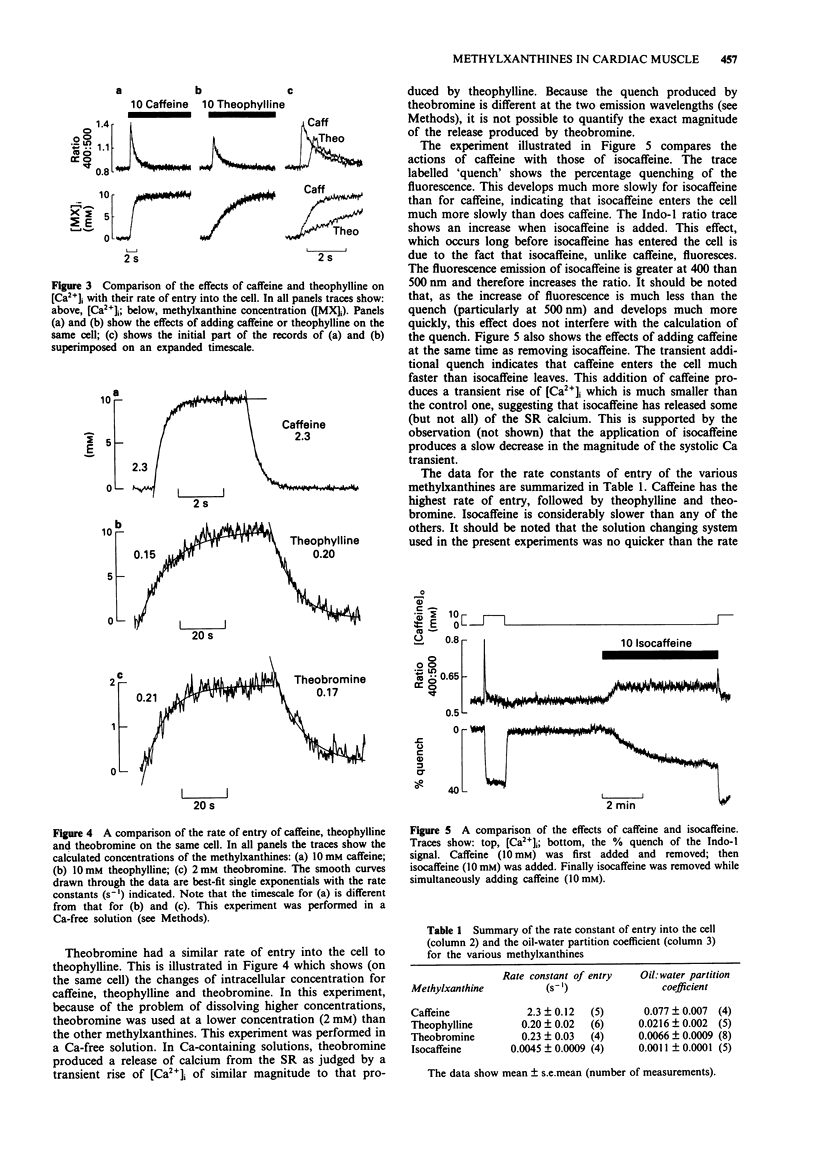Abstract
1. The effects of caffeine and other methylxanthines were investigated on intracellular calcium concentration ([Ca2+]i) and contraction in rat isolated ventricular myocytes. The use of the fluorescent indicator, Indo-1, allowed simultaneous measurement of [Ca2+]i and the intracellular concentration of the methylxanthines. 2. Rapid application of caffeine (10 mM) produced a transient rise of [Ca2+]i which decayed to resting levels. This was accompanied by a transient contraction which decayed to a level above baseline. The addition of theophylline also produced a transient increase of [Ca2+]i. However, following the initial transient, contraction decayed before redeveloping to a maintained level. 3. Direct measurements showed that [caffeine]i rose more quickly than did [theophylline]i. The slower rise of [theophylline]i was associated with a delay in the increase of [Ca2+]i. At lower concentrations of the methylxanthines, theophylline was less effective than caffeine at initiating Ca release. The rate of entry of theobromine was similar to that of theophylline. 4. Isocaffeine did not produce a rise of [Ca2+]i. The rate of rise of [isocaffeine]i was much slower than that of either caffeine or theophylline. 5. Measurements of the oil:water partition coefficient showed that the order of relative partitioning into oil was: caffeine > theophylline > theobromine > isocaffeine. This is similar to the order of rate of entry into the cell. 6. We conclude that many of the differences in the effects of these methylxanthines can be attributed to differences in membrane permeability due to differences in oil:water partition.
Full text
PDF



Selected References
These references are in PubMed. This may not be the complete list of references from this article.
- Baró I., O'Neill S. C., Eisner D. A. Changes of intracellular [Ca2+] during refilling of sarcoplasmic reticulum in rat ventricular and vascular smooth muscle. J Physiol. 1993 Jun;465:21–41. doi: 10.1113/jphysiol.1993.sp019664. [DOI] [PMC free article] [PubMed] [Google Scholar]
- Chapman R. A., Miller D. J. Structure-activity relations for caffeine: a comparative study of the inotropic effects of the methylxanthines, imidazoles and related compounds on the frog's heart. J Physiol. 1974 Nov;242(3):615–634. doi: 10.1113/jphysiol.1974.sp010726. [DOI] [PMC free article] [PubMed] [Google Scholar]
- Eisner D. A., Nichols C. G., O'Neill S. C., Smith G. L., Valdeolmillos M. The effects of metabolic inhibition on intracellular calcium and pH in isolated rat ventricular cells. J Physiol. 1989 Apr;411:393–418. doi: 10.1113/jphysiol.1989.sp017580. [DOI] [PMC free article] [PubMed] [Google Scholar]
- Grynkiewicz G., Poenie M., Tsien R. Y. A new generation of Ca2+ indicators with greatly improved fluorescence properties. J Biol Chem. 1985 Mar 25;260(6):3440–3450. [PubMed] [Google Scholar]
- Highsmith S., Bloebaum P., Snowdowne K. W. Sarcoplasmic reticulum interacts with the Ca(2+) indicator precursor fura-2-am. Biochem Biophys Res Commun. 1986 Aug 14;138(3):1153–1162. doi: 10.1016/s0006-291x(86)80403-x. [DOI] [PubMed] [Google Scholar]
- O'Neill S. C., Donoso P., Eisner D. A. The role of [Ca2+]i and [Ca2+] sensitization in the caffeine contracture of rat myocytes: measurement of [Ca2+]i and [caffeine]i. J Physiol. 1990 Jun;425:55–70. doi: 10.1113/jphysiol.1990.sp018092. [DOI] [PMC free article] [PubMed] [Google Scholar]
- O'Neill S. C., Eisner D. A. A mechanism for the effects of caffeine on Ca2+ release during diastole and systole in isolated rat ventricular myocytes. J Physiol. 1990 Nov;430:519–536. doi: 10.1113/jphysiol.1990.sp018305. [DOI] [PMC free article] [PubMed] [Google Scholar]
- Rousseau E., Ladine J., Liu Q. Y., Meissner G. Activation of the Ca2+ release channel of skeletal muscle sarcoplasmic reticulum by caffeine and related compounds. Arch Biochem Biophys. 1988 Nov 15;267(1):75–86. doi: 10.1016/0003-9861(88)90010-0. [DOI] [PubMed] [Google Scholar]


